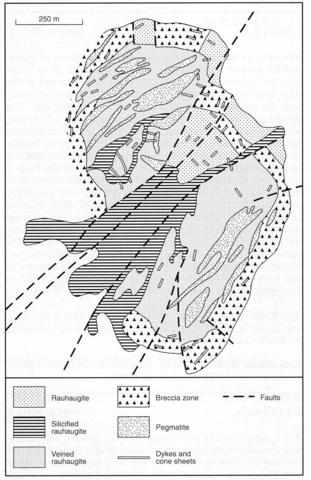stripes
Located in an area of Upper Karoo sandstones in the Rufunsa Rift, which is in the mid-Zambezi-Luangwa rift zone, the Kaluwe occurrence forms a crescentic outcrop nearly 10 km in length. It comprises a substantial sheet of carbonatitic rocks up to 250 m thick concordant with adjacent Karoo sandstones. There have been some differences of opinion regarding the relationship of the carbonatites to the Karoo, which is closely linked with the interpretation of the emplacement of the carbonatites. Bailey (1960 and 1966) considers that the carbonatites were intruded conformably into a gentle syncline of Karoo sandstones pitching 15° to the north. Turner (1988), however, concluded that the carbonatites are extrusive, but thought that the evidence is not clear as to whether the carbonatites overlie the Karoo or are part of the Karoo succession. He interpreted the complex as a subaerial succession of tuffs, agglomerates, lavas and epiclastic sediments. The carbonatites comprise numerous layers of breccia, agglomerate and finer-grained fragmental material and Bailey (1960) was able to map upper, middle and lower facies, but there are numerous distinct layers ranging from a few centimetres to 2-3 m in thickness. There are rare cross-cutting veins and thin dykes but cross-cutting relationships between the main conformable layers are scarce. The basal units contain fragments of Karoo sandstone and mudstone and within the Middle facies are rounded blocks of carbonatite, typically 10 cm in diameter, in finer tuff-like material. Turner (1988) recognised graded bedding and layers containing magnetite and apatite crystals, quartz pebbles and carbonatite fragments that he interpreted as palaeosols filling solution hollows in the surface of lava flows. Clasts of carbonatite, Karoo sediments and Precambrian basement rocks are more abundant in the Upper facies, particularly towards the top, the whole assemblage being interpreted by Turner (1988) as sediments. Bailey (1960) describes fragments that appear to be basement rocks that have been completely replaced by K-feldspar with the development sometimes of phlogopite; these are the only manifestations of fenitization apparent at Kaluwe. Under the microscope the rocks thought by Turner to be lavas are seen to contain aligned calcite plates, which he interprets as after nyereite, magnetite and apatite. Although most of the finer-grained carbonatitic rocks are made of fragments or clasts of carbonatite in a few units round masses of carbonate with apatite and magnetite in a matrix of sparry calcite are interpreted as lapilli. The fine-grained matrices of lapilli, considered to be pseudo-nyereite by Turner (1988), have been shown to be dolomitic, ruling out the possibility of replacement of an earlier natrocarbonatite (pers. comm., D.K. Bailey, 1998; Ngwenya and Bailey, 1990). Most of the coarse blocks prove to be sovite, but some ferrocarbonatite fragments also occur. Photographs and sketches illustrating textural and field relationships will be found in Bailey (1960) and Turner (1988). The main differences in interpretation are summarised in the published discussion at the end of Turner (1988). See also the age data of Turner and Rex (1991) below. Ziegler (1992) gives whole rock and trace element, including REE, data for three sovites as well as Rb, Sr, Sm and Nd isotopes.
BAILEY, D.K. 1960. Carbonatites of the Rufunsa Valley, Feira District. Bulletin, Geological Survey of Northern Rhodesia, 5: 1-92.BAILEY, D.K. 1966. Carbonatite volcanoes and shallow intrusions in Zambia. In O.F. Tuttle and J.Gittins (eds) Carbonatites. 127-54. John Wiley, New York.D.K. Bailey, pers. comm., 1998.NGWENYA, B.T. and BAILEY, D.K. 1990. Kaluwe carbonatite, Zambia: an alternative to natrocarbonatite. Journal of the Geological Society, London, 147: 213-6.TURNER, D.C. 1988. Volcanic carbonatites of the Kaluwe complex, Zambia. Journal of the Geological Society, London, 145: 95-106.TURNER, D.C. and REX, D.C. 1991. Volcaniclastic carbonatite at Kaluwe, Zambia: age and relations to sedimentary rocks in the Zambezi rift valley. Journal of the Geological Society, London, 148: 13-5.TURNER, D.C., ANDERSEN, L.S., PUNUKOLLU, S.N., SLIWA, A. and TEMBO, F. 1989. Igneous phosphate resources in Zambia. In A.J.G. Notholt, R.P. Sheldon and D.F. Donaldson (eds), Phosphate deposits of the world, 2. Phosphate rock resources. 247-57. Cambridge University Press, Cambridge. ZIEGLER, U.R.F. 1992. Preliminary results of geochemistry, Sm-Nd and Rb-Sr studies of post-Karoo carbonatite complexes in southern Africa. Schweizerische Mineralogische und Petrographische Mitteilungen. Zurich, 72: 141-8.

